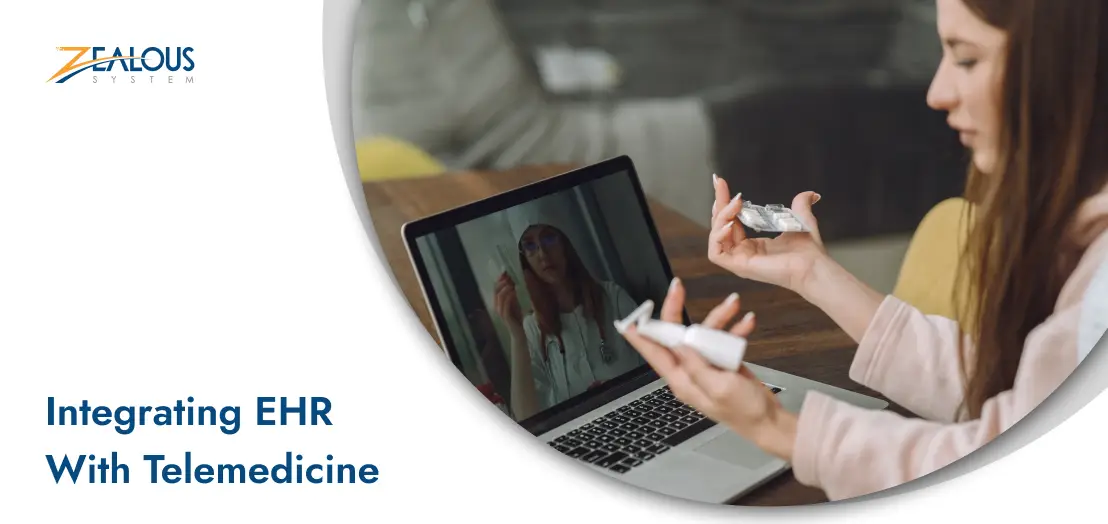
We use cookies and similar technologies that are necessary to operate the website. Additional cookies are used to perform analysis of website usage. please read our Privacy Policy
How to Integrate EHR With Telemedicine?

The healthcare industry has been evolving rapidly, particularly with the advent of digital technologies. Two of the most transformative innovations in recent years are Electronic Health Records (EHR) and telemedicine. Integrating EHR with telemedicine offers numerous benefits but also presents several challenges. This comprehensive guide explores the advantages and obstacles of this integration, providing insights for healthcare providers and IT professionals.
Since the COVID-19 pandemic, one of the most prominent transformations has been in healthcare delivery. As social distancing had become necessary and hospitals faced new challenges, telemedicine became incredibly important. It gave access to medical care at home, keeping the patients safe. This change showed how telemedicine could change healthcare worldwide.
Telemedicine is helpful, but it works best when it’s connected to Electronic Health Records (EHRs). EHRs are like digital files that contain all your health information, like doctor visits, test results, and medications.
When telemedicine is integrated with EHRs, it means doctors can see all this information in one place and use it to make better decisions about the patient’s health. This makes it easier for them to coordinate a patient’s care, improve how well treatments work, and make their work more efficient.
The blog will navigate the ways to help you integrate EHR with Telemedicine and understand its benefits and challenges.
What Is EHR(Electronic Health Report)?
An Electronic Health Record (EHR) is a digital record of a person’s health information that is stored electronically. It contains complete details such as medical history, diagnoses, medications, allergies, immunization records, laboratory test results, and more. EHRs allow healthcare providers to access and manage this information efficiently, ensuring they have a complete view of the patient’s health over time.
Having understood EHR, we need to discuss what telemedicine is.
What is Telemedicine?
Telemedicine refers to the practice of providing healthcare services remotely through telecommunications technology. It allows patients to consult with doctors, nurses, therapists, and other healthcare professionals using video calls, phone calls, secure messaging platforms, or other digital tools. This approach allows for medical consultations and treatments to be conducted without the need for in-person visits to a healthcare facility.
We know that EHR and Telemedicine are helping patients and healthcare professionals by making record-keeping hassle-free and all the information available at their fingertips. Let us see how to successfully integrate them.
Tips To Successfully Integrate EHR Software With Telemedicine
Integrating electronic health records (EHRs) into your practice requires careful planning and preparation to ensure a successful implementation.
To set the stage for a seamless integration process, consider the following steps:
1. Set The Scope Of The Program
Choose which virtual services you want to offer and how you’ll provide them. Some medical specialties and situations may still require an in-person visit to the doctor’s office. Using a scheduling system, healthcare providers can let patients book their own appointments. This helps manage appointments more efficiently and makes it easier for patients to see the doctor when they need to.
2. Develop Workflows For Virtual Care
In any digital health platform, developing workflows for virtual care means creating organized steps or routines that healthcare providers follow to make virtual appointments and treatments efficient and effective. Creating these workflows helps healthcare providers deliver consistent care, maintain patient confidentiality, and ensure that virtual appointments are as effective as in-person visits. It also helps in managing time efficiently and providing quality care to patients.
3. Transform calls into virtual calls
Seamlessly switching the calls to virtual calls or video calls aka virtual visits is useful for healthcare workers who need to see their patients quickly in urgent situations. It allows them to continue the conversation visually while still addressing the patient’s needs effectively.
4. Patient-centric application
Let your patients access a portal or download an app to review all of their health information. Patients can use their portal to access the results of diagnostic tests, book online appointments, and access educational materials. Integration of telehealth and EHR improves patient care while simplifying care administration for the medical staff.
Benefits of Integrating Telemedicine With EHR

Let us explore how integrating Telemedicine with EHR benefits patients and health professionals:
1.Automated Data Entry
Integrating electronic health records (EHR) with telehealth benefits a healthcare provider to conduct a virtual visit with a patient. The information from that visit can automatically occupy the patient’s medical records. This eliminates the need for the provider to spend extra time entering data manually after each appointment.
Furthermore, having up-to-date and accurate medical records readily available can improve the overall quality of care. It ensures that all healthcare providers involved in a patient’s treatment have access to the most current information, which is crucial for making informed decisions and providing coordinated care.
2. Syncing Patient Information
Another benefit is the ability to sync patient information. When healthcare providers sync patient data between electronic health records (EHR) and telehealth platforms, it means they can access the most up-to-date information about patients during virtual appointments. This helps reduce mistakes in medical care and makes the treatment given better.
Having this synced information also makes sure that the doctor makes informed decisions about the patient’s health. They can provide accurate diagnoses, prescribe the right medications, and plan effective treatments based on the most current data available. This integration between EHR and telehealth improves the overall quality of care by keeping all healthcare providers on the same page and reducing the chances of medical errors.
3. Seamless Virtual Delivery
Integrating electronic health records (EHR) with telehealth solutions is beneficial to healthcare providers as they can easily treat patients virtually from any location and at any time. This means patients can access medical care more conveniently, which improves their health outcomes, especially if they have difficulty with transportation or mobility
This software integration makes healthcare more accessible because patients don’t have to physically go to the doctor’s office. It saves time and effort for both patients and healthcare providers. For instance, elderly patients or those with disabilities can receive timely care without the challenges of transportation.
4. Data-driven Decision Making
A major benefit of integrating EHR with telemedicine in the health industry is that it allows healthcare providers to quickly access patient information during virtual appointments. This helps them make fast and informed decisions, which is crucial during emergencies or when urgent medical decisions are needed.
Having real-time access to this data allows the doctor to make evidence-based decisions promptly. For example, they can determine the best course of action for treatment, adjust medications, or recommend further tests based on the current health information available. This capability is particularly important in emergencies where every minute counts.
The benefits are innumerable without a doubt. However, we cannot overlook the challenges that arise with integrating Telemedicine with EHR.
Challenges of EHR Implementation with Telemedicine and How To Overcome Them

Integrating Telemedicine with EHR has its set of problems too. Navigating these challenges requires careful planning and collaboration between healthcare IT teams and telemedicine providers.
Let us look into these challenges and ways to overcome them:
1. Compatibility problems with your current system
It is a challenge to ensure that telemedicine platforms and EHR systems can seamlessly communicate and share data. Different systems may use different data formats or standards, making integration complex and requiring interoperability solutions.
Solution – There is a need to thoroughly analyze your current systems and develop tailored integration solutions that ensure seamless data flow and interoperability between all relevant applications.
2. Integration Cost
Another challenge of Integrating Electronic Health Records (EHR) is that it can be costly. This is due to various expenses such as purchasing software licenses, upgrading hardware, transferring existing data to the new system, and maintaining ongoing support and updates.
These costs are important investments aimed at improving healthcare delivery, efficiency, and patient outcomes.
Solution – Effective integration involves careful planning to manage expenses associated with software licensing, hardware upgrades, data migration, and ongoing maintenance and support. By collaborating closely, one can tailor the approach to minimize upfront costs while maximizing long-term benefits
3. Resistance to adopt
When introducing new technology like Electronic Health Records (EHR) systems, a common challenge faced is that some staff members might be hesitant because they’re used to doing things a certain way. They might feel uncertain or worried about how the new system will affect their daily tasks and routines.
Solution – To overcome this resistance, it’s important to address staff concerns and involve them in the transition process. Providing training sessions, demonstrations, and support can help them feel more confident with the new system. Showing how the EHR system can make their work easier, such as faster access to patient information or reducing paperwork, can also encourage acceptance.
4. Problems with Data Privacy
When integrating Electronic Health Records (EHR), a major challenge is to protect patient privacy and follow regulations like HIPAA (Health Insurance Portability and Accountability Act).
HIPAA sets strict rules for how healthcare providers must handle and protect patients’ health information. It requires safeguards like encryption for electronic records, secure transmission methods for data, and policies to control who can access patient information.
Solution – To integrate telemedicine with EHR systems securely, healthcare organizations should prioritize HIPAA adherence, strong encryption for data protection, strict access controls with multi-factor authentication, and robust audit trails. Regular risk assessments, data backup and software updates will help comply with the security needs.
Conclusion
Integrating EHR with telemedicine offers significant benefits, including improved patient care, increased efficiency, better patient engagement, cost savings, and enhanced data security. However, it also presents challenges such as technical hurdles, privacy and security concerns, financial constraints, resistance to change, and legal issues.
By following best practices and addressing these challenges proactively, healthcare providers and healthcare software development companies can successfully implement an integrated EHR-telemedicine system that improve the quality of care and operational efficiency.
We are here
Our team is always eager to know what you are looking for. Drop them a Hi!
Umang Baraiya
I am currently working as a business analyst at Zealous System. I am experienced in working with stakeholders and managing project requirements, Documentation of requirements, and planning of product backlog.
Table of Contents
×


Comments